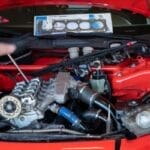Deer collisions are not an uncommon occurrence in the fall and winter season, especially in Georgia. While the likelihood of a vehicle collision is much more likely, it doesn’t mean you should let your guard down to the possibility of a deer collision. Follow these tips for how to avoid hitting a deer with your car to keep yourself and the animals safe.
If There’s One, There’s Many
Deer tend to travel in packs. This means if you notice one deer on the side of the road, there’s likely more nearby. Drivers should take this as a sign to slow down and be more alert while traveling through the area.
Take Note of Timing
Deer are far more active during mating season, between October and January, and near dusk or dawn. Unfortunately, we can’t see as clearly at dusk compared to a bright and sunny afternoon. It’s best to keep these are times in mind when driving. Make sure to slow down and watch your surroundings more diligently.
Don’t Swerve
If there’s a deer on the road, your first instinct might be to swerve out of the way. Doing so might put you at greater risk. Instead of swerving, you should brake hard and stay in your lane. Swerving can confuse the animal, cause you to lose control of your vehicle, or lead to a collision with another car on the road.
Use Your Horn
You shouldn’t rely solely on your horn to keep deer out of the way, but honking your horn can spook the deer. Slowing down and braking should be your first reaction to seeing a deer, but a honk might aid in scaring the animal away.
Following these tips for how to avoid hitting a deer with your car can keep you feeling safe on rural roads. It can also save you from standing on the side of the road wondering what to do after you’ve hit a deer.








































